2020 challenged much of what we have long held dear about higher education. In this unprecedented year, nearly 100% of all students experienced some form of remote learning and 74% of enrolling seniors attended a virtual recruiting event. Four percent fewer undergraduates and 13% fewer freshmen enrolled in school. And now, 20% of freshmen have told us they are, at best, unsure about whether they will return for a second term.
The past year tested us in fundamental ways; the question is, what did we learn?
Six Eduventures analysts reflect on this question, drawing on findings from their research in 2020.
Click the author to jump to each section:
Richard Garrett: Traditional Students Like Online Built for Them (But it Rarely Is)
Kim Reid: College is More than the Classes
Johanna Trovato: Schools Have Inadvertently Reached More Minority Students
Howard Lurie: 2020 Adult Learner Demand: Two Sides of the Same Coin
James Wiley: Zooming into Higher Ed
Traditional Students Like Online Built for Them (But it Rarely is)
Richard Garrett, Chief Research Officer
I learned this year that online learning designed for traditional students has strong appeal—but few schools are paying attention.
The pandemic battered higher education this fall. Seeing colleges struggle with “remote instruction,” first-time undergraduate enrollment tumbled 13%, according to the National Student Clearinghouse (NSC). By contrast, traditional-aged enrollment at primarily online schools is up 13%.
Just a pandemic oddity? NSC reports that the same population (undergraduates aged 18-20 at online schools) grew 10% the previous fall as well.
Figure 1 shows how younger students have trended at online schools.
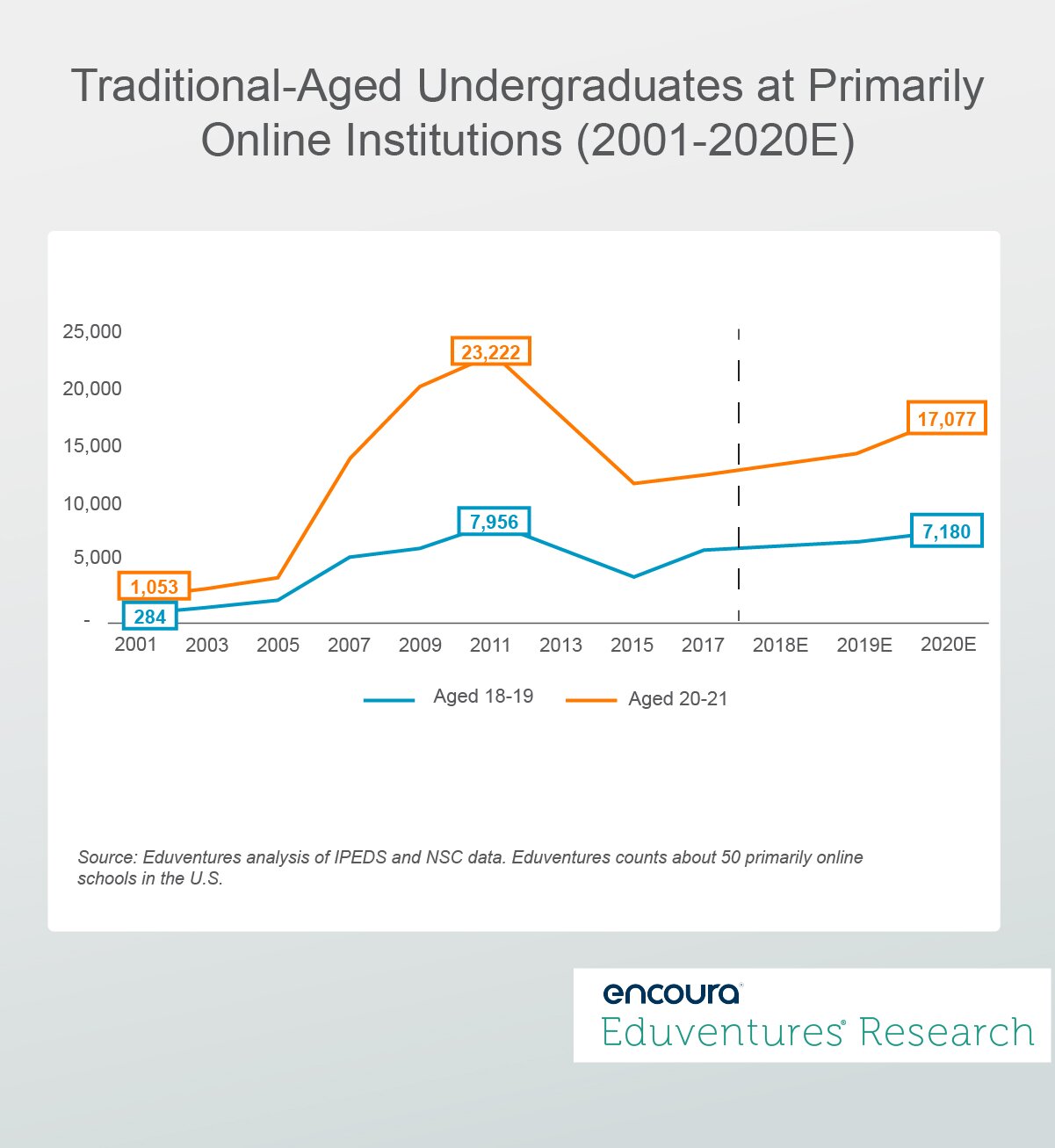
Traditional-aged enrollment at online schools peaked following the Great Recession, primarily at for-profits messaging career value, customer service, and convenience. Adults were the main audience, but younger students also signed up.
Economic recovery and regulatory scrutiny of for-profits saw enrollment collapse. But post-2015, trends improved.
Notably, despite renewed growth, online schools dedicated to traditional-aged students (as opposed to schools making a “remote pivot” during a pandemic) are conspicuously absent.
There are two exceptions: Minerva and University of Florida-Online are both part of the resurgence in Figure 1. These are the only schools in the country with a majority of traditional-aged students enrolled fully online: 100% at Minerva and about 60% at UF-Online.
Both wrap in-person elements around 100% online academics. Minerva provides a highly-selective, synchronous-online, multi-site, travel experience, while UF-Online manages excess campus demand, offering the chance to attend the Gainesville campus as a sophomore. Many students move to Gainesville right away to be part of campus life. Both schools have invested in online production and pedagogy, and continue to grow in appeal, reputation, and, in UF’s case, size.
COVID-19 may produce an outbreak of campus nostalgia short-term. But expect to see more schools follow Minerva and UF-Online: creating hybrid experiences that transcend the traditional campus or—for oversubscribed institutions—using online to boost capacity and economies of scale.
Most are not designed for such students, and often prove a poor fit. But when the fit is there, the market responds.
College is More than the Classes
Kim Reid, Principal Analyst
In 2020, I learned that first-time freshmen are navigating a higher education experience where a product that was only ever marginally understood is now deeply obscured.
; this is a seismic amount of retention risk. And it’s due in large part to the current instability and lack of clarity around the higher education product.
Our research shows dissatisfaction among all students relates to two major factors: the notion that students are not getting their money’s worth and the loss of community. A closer look at those students who are likely to be non-returners reveals two other important factors: curtailed career opportunities and impeded ability to explore passions.
What’s not present as a fundamental driver of dissatisfaction among this high-risk group? The ability to get a full academic experience. Figure 2 shows this by comparing the influence of drivers of dissatisfaction with the fall college experience across categories of fall-to-spring retention risk. It shows where the promise of the educational product has its cracks.
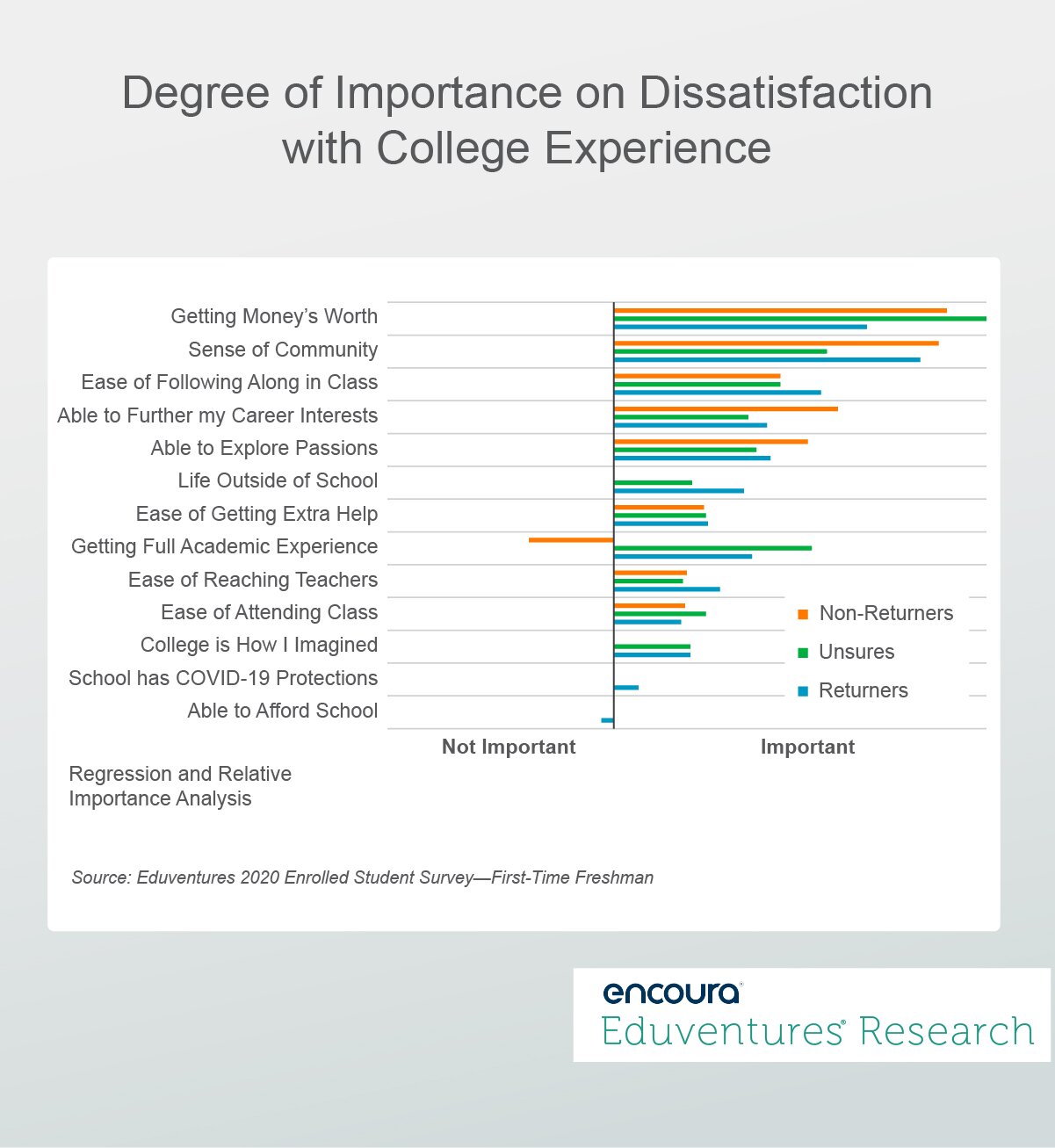
Thus, COVID-19 has exposed a heightened sense of lost opportunity for students and a yearning for expansive growth toward outcomes hard and soft. Aren’t these things that students have always been seeking? In a singular, clarifying moment, COVID-19 has laid them bare.
As institutions move past the pandemic, they would do well to remember that excellence in the academic enterprise and in the student experience more broadly is always in service to students’ abilities to pursue passions and opportunities. These are the make-or-break features of the higher education product. They have been in the past and they will be more than ever in the future.
Schools Have Inadvertently Reached More Minority Students
Johanna Trovato, Senior Analyst
In 2020, I learned that the virtual recruitment environment, to which most institutions pivoted in the spring, may have provided underserved racial minority students more access to information about colleges. Schools that increased their social media efforts as part of their virtual outreach—and many have—reached more of these students.
Our 2020 Student Sentiment Research shows that as more schools began relying more heavily on social media, more students also used the most common platforms for search. Use of YouTube increased by 14% and Instagram by 10% compared to 2019, and the number of students liking or following schools across any platform increased by 5%. Perhaps more importantly, our data shows that (Figure 3).
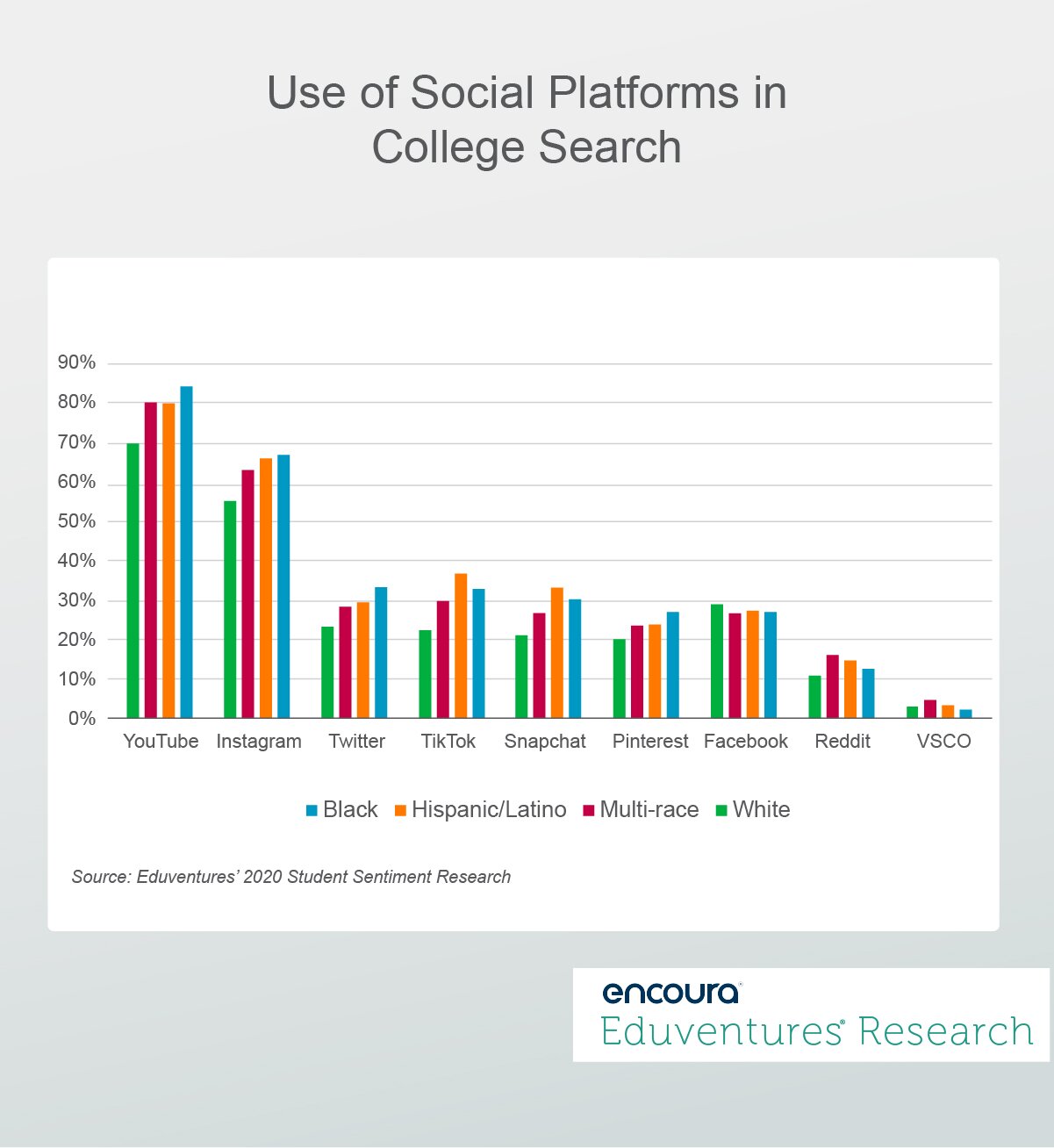
We know that students of color have been disproportionately impacted by the COVID-19 pandemic, and their college attendance has suffered as a result. While those circumstances may not change in the near future, we also know there are institutions who wish to recruit more students of color, but don’t know how to reach them.
Social media provides a way to catch the attention of these students. It also allows schools that already depend on this demographic to better connect with these prospects. The key to a successful outreach on social platforms, of course, hinges on the ability to create relevant content for the audiences they will reach. Do you know if your social platform content attracts or deters students of color?
The COVID-19 pandemic has widened the inequality gap for many students. My hope for 2021 is that it will give us inspiration and insight about how to close this gap.
2020 Adult Learner Demand: Two Sides of the Same Coin
Howard Lurie, Principal Analyst
In 2020, I learned that adult-learner demand is best thought of as two sides of the same coin.
On one side, global pandemic and economic collapse have yet to diminish the appeal of postsecondary degree attainment. On the other side, converting interest into enrollment remains a slow and uneven process.
During 2020, I pored over Eduventures survey data from three moments in time: summer 2019 (our pre-pandemic baseline), June 2020, and October 2020. While many had hoped for the typical countercyclical enrollment boom experienced during past recessions, I expected a broad repudiation of postsecondary degrees, and an historic embrace of shorter and cheaper alternatives. Given the unique nature of the pandemic, I feared the worst: that the combination of a public health crisis and a precipitous loss of income might conspire to upend adult learner preferences for postsecondary credentials.
Despite these expectations, . Figure 4 tracks credential preferences between summer 2019 and October 2020.
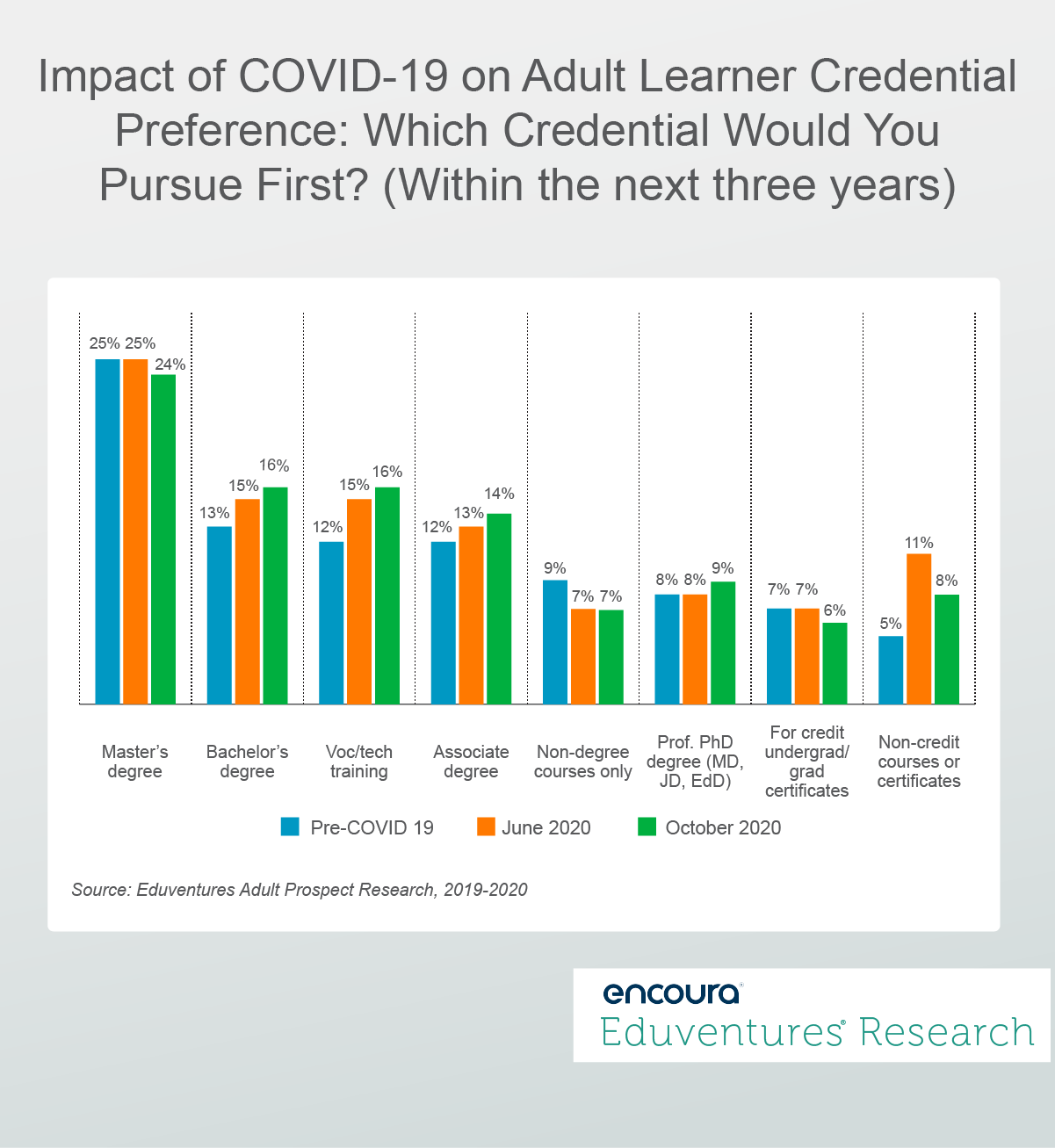
Interest in master's degrees is stable and continues to outpace other credentials, consistent with above-average enthusiasm for further education among bachelor's degree holders. Interest in bachelor’s and associate degrees has increased, a sign that the economic shock may be convincing more adults without degrees that they need one. There’s also a healthy bump in preferences for vocational or technical training, an extension of a pre-pandemic trend toward workplace-focused learning. The June 2020 spike in interest in non-credit courses or certificates has subsequently faded, a sign that campus re-openings this fall may have persuaded adults that more conventional pathways were an option again.
The irony is that the very adults with the greatest increased interest in school—those seeking undergraduate degrees—saw some of the steepest enrollment declines this fall. The National Student Clearinghouse (NSC) reports that freshmen aged 21 and older declined more than average—a drop as high as 24% for those over age 30. While interest may be solid, many adults have delayed enrollment until the pandemic is under control.
In 2021, schools should anticipate both sides of the adult learner coin: postsecondary interest will continue, but the willingness and ability of adults to convert their interests into actual enrollment near-term remains fragile and uneven.
Proctor Madness
Mike Miller, Senior Analyst
In 2020, I learned how well-intended edtech can go off the rails—in a hurry. The rapid deployment of proctoring solutions amid the COVID-19 pandemic provided a prime example.
Since the onset of the pandemic, hundreds of thousands of students have signed petitions calling for an end to the use of proctoring solutions, alleging that they are some combination of invasive, unnecessary, ableism, or biased. Heated battles have turned into legal battles and even the U.S. Senate has gotten involved. This fresh wave of pushback has taken many by surprise, partially because proctoring solutions are not exactly new.
Figure 5, based on Eduventures 2020 analysis of the Assessment Integrity Solutions market, a technology segment comprised of these proctoring solutions, shows that their use has grown steadily over the last decade. In most cases, these solutions were not pandemic-driven acquisitions—they were already widely in use. In fact, while 2020 will likely be a strong growth year for these products, it may not even eclipse years past.
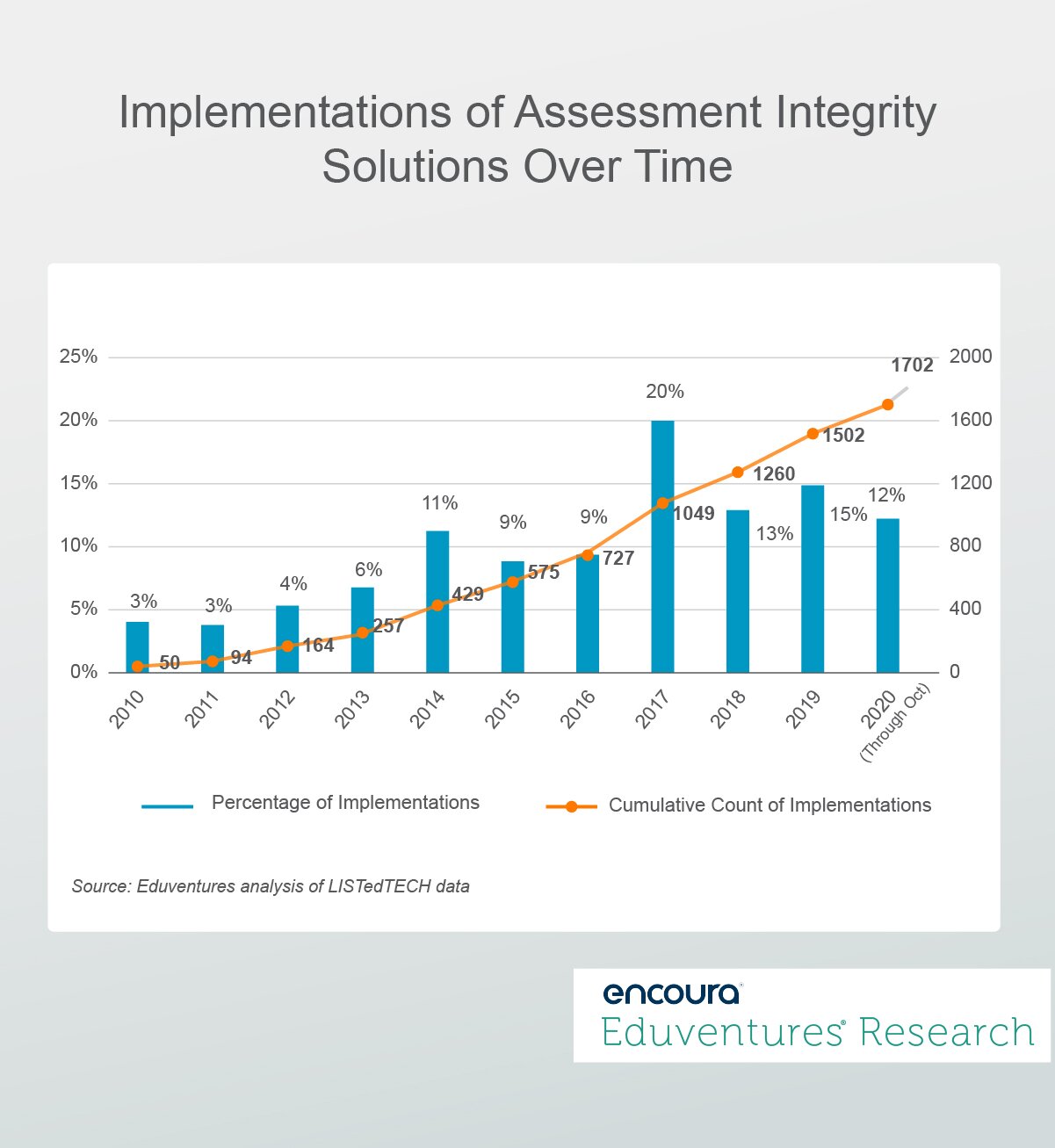
So, what went wrong?
Part of the pushback is likely the result of what were widely considered, solidly field-tested, plug-and-play products being rapidly introduced to a new user base of both students and faculty. There may also be a generational gap. Whereas proctoring technologies may have been more widely accepted, even requested, by adult learners in online programs to limit the need to come to campus, there is now a critical mass of predominantly (but not exclusively) traditional-aged students on some campuses who see common functions of proctoring products—webcam and CPU monitoring, browser lockdown, and/or biometric driven identification functionalities—as unacceptable forms of surveillance. Finally, the concerns of racial bias simply cannot be ignored.
But schools are taking action. In some cases, they have changed testing policies allowing students to seek alternatives. In others, assessment has been reimagined in order to, among other things, limit or preclude the need for any sort of integrity check that involves webcams or monitoring computer usage.
Moving forward, vendors will need to seriously re-assess functionality that is producing biased results. And institutions will have to step up their communications about these products: developing fair policies that acknowledge student concerns, and being more transparent about their use in courses up front.
Zooming into Higher Ed
James Wiley, Principal Analyst
In 2020, I was surprised to learn how many vendors have pivoted into the higher education technology market from other markets since 2016. Perhaps the most recent and visible example of this is the sudden ubiquity of Zoom—a product originally used by (or designed for) the world of business—adopted in mass by higher education in a matter of weeks to enable remote learning.
Why is this insight important? While other market research firms focus on the appearance of new products entering the market (with some stakeholders predicting significant changes resulting from COVID-19), our analysis uncovers a more profound fluidity in the higher education market. Zoom and other products in the Productivity and Collaboration Tools segment exemplify this fluidity by building on standard features used in other contexts to offer education-specific functionality.
Data from our 2020 Higher Education Technology Landscape (Landscape) reveals that one in five market changes is due to these market pivots. The remaining changes are due to a combination of new products that have appeared since 2016 and two other factors:
- Consolidation: Changes that have resulted from a consolidation of one product into another product offered by the same vendor, such as the folding of Blackboard's standalone X-Ray Analytics solution into its Learning Management System.
- Acquisition: Changes that have resulted from the purchase of one vendor's product by another vendor, such as Oracle's acquisition of the Vocado financial aid solution.
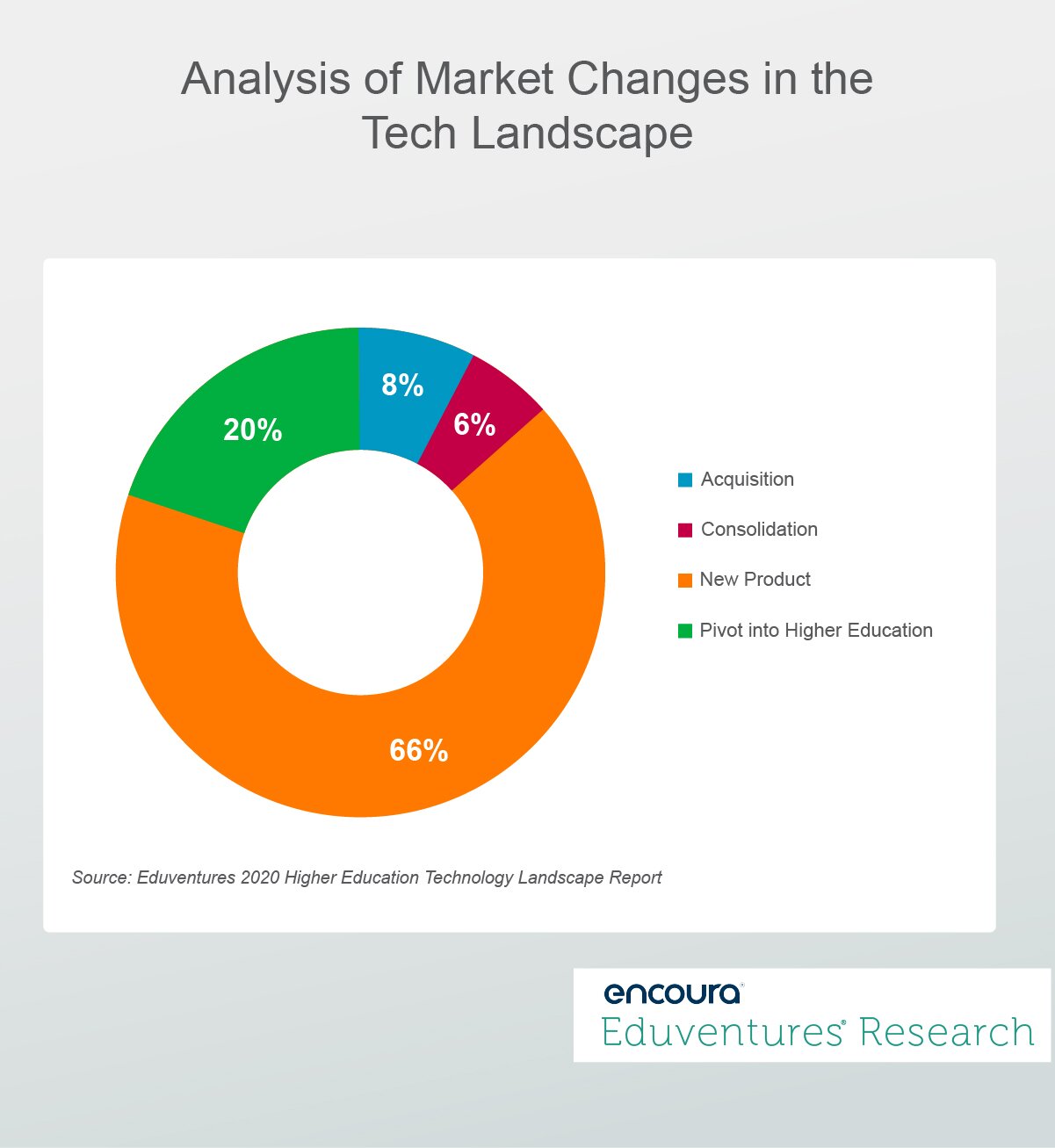
This analysis shows that . Institutional leaders may see the value in how System Integration Solution products like SnapLogic have helped financial services or healthcare companies unlock data from siloed applications, deciding to deploy them to reduce the complexity of institutional ecosystems. In 2021 and beyond, we believe that institutions will continue to look at products traditionally used outside of higher education, such as Identity and Access Management Solutions, which will increase the number of vendors pivoting into the higher education technology market.
Never Miss Your Wake-Up Call
Learn more about our team of expert research analysts here.
More Wake-Up Calls
Never Miss Your Wake-Up Call
Learn more about our team of expert research analysts here.

